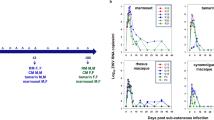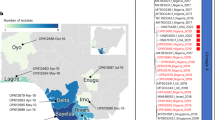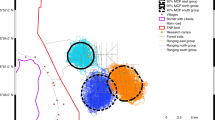Abstract
Chimpanzees (Pan troglodytes troglodytes) from west central Africa are recognized as the reservoir of simian immunodeficiency viruses (SIVcpzPtt) that have crossed at least twice to humans: this resulted in the AIDS pandemic (from human immunodeficiency virus HIV-1 group M) in one instance and infection of just a few individuals in Cameroon (by HIV-1 group N) in another1. A third HIV-1 lineage (group O) from west central Africa also falls within the SIVcpzPtt radiation2, but the primate reservoir of this virus has not been identified1. Here we report the discovery of HIV-1 group O-like viruses in wild gorillas.
Similar content being viewed by others
Main
More than 30 African primate species are known to carry simian immunodeficiency viruses3, but chimpanzees are the only apes known to harbour viruses closely related to HIV-1 (refs 1, 2). We tested 378 chimpanzee and 213 gorilla fecal samples from remote forest regions in Cameroon for HIV-1 cross-reactive antibodies (for map, see supplementary information). Consistent with previous findings1, 40 of 323 specimens from P. t. troglodytes, but none of 55 samples from P. t. vellerosus, contained antibodies reactive against HIV-1 (for details, see supplementary information).
Surprisingly, 6 of 213 fecal samples from wild-living gorillas also gave a positive HIV-1 signal. All six contained antibodies that bound the HIV-1 envelope glycoprotein (gp41) in a recombinant-based immunoassay (see supplementary information), as well as the HIV-1 Env (gp160/gp120, gp41) and Pol (p66, p51) proteins in a confirmatory western blot (Fig. 1a).
a, Detection of HIV-1 cross-reactive antibodies in gorilla fecal samples by western-blot analysis. Samples are numbered, with their collection site indicated (for details, see supplementary information); samples from the same individual (ID) are grouped. The relative molecular masses of HIV-1 glycoproteins (gp) and proteins (p) are indicated as a suffix (in thousands). Sera from infected (M and O) and uninfected (neg) humans are shown as controls. b, Evolutionary relationships of SIVgor (red), the three groups of HIV-1 (blue), and SIVcpz. Partial Pol sequences were analysed by the bayesian method; posterior probability values above 95% are shown.
Fecal RNA was extracted from all antibody-positive gorilla specimens and amplified by reverse transcription with polymerase chain reaction. Subgenomic pol (about 890 base pairs), env (about 390 base pairs) and/or env/nef (about 740 base pairs) sequences were amplified from five samples derived from three gorillas (as determined by mitochondrial and microsatellite analyses of fecal DNA; see supplementary information). Phylogenetic analysis of these sequences revealed that each of the three gorillas was infected by a distinct strain of SIV. The gorilla viruses clustered together, forming a monophyletic lineage within the SIVcpzPtt radiation that was much more closely related to HIV-1 group O than was any other known SIV (Fig. 1b, and see supplementary information). We designate this new viral lineage 'SIVgor'.
The finding of distinct but related SIVgor strains in gorillas living nearly 400 km apart suggests that, as in chimpanzees, SIV infection is endemic in gorillas. An alternative explanation could be that gorillas acquire SIV sporadically from chimpanzees, but this seems unlikely as no chimpanzee community surveyed so far, including several from habitats that overlap with those of the SIVgor-positive gorillas, harbour group O-like viruses (see supplementary information). The phylogenetic relationships shown in Fig. 1b argue that chimpanzees were the original reservoir of SIVs now found in chimpanzees, gorillas and humans; that distinct chimpanzee communities in southern Cameroon transmitted divergent SIVcpz to humans, giving rise to HIV-1 groups M and N1; and that chimpanzees transmitted HIV-1 group O-like viruses either to gorillas and humans independently, or to gorillas that then transmitted the virus to humans.
Gorillas are classified into two species, the western Gorilla gorilla and eastern G. beringei, which in turn are subdivided into four sub-species (G. g. gorilla, G. g. diehli, G. b. beringei and G. b. graueri)4. We screened the two western subspecies and found SIVgor in only G. g. gorilla. Additional field studies are needed to determine the overall prevalence, subspecies association, genetic diversity and natural history of SIVgor infection in wild gorillas. It will also be important to determine by what route gorillas acquired SIVgor, given that these apes are herbivores and physical encounters between gorillas and chimpanzees are believed to be rare5. Gorillas are hunted for food6,7 and medi-cinal use8, and it is possible that these practices may have been responsible for the HIV-1 group O zoonosis and could pose an ongoing risk to humans.
References
Keele, B. F. et al. Science 313, 523–526 (2006).
Sharp, P. M., Shaw, G. M. & Hahn, B. H. J. Virol. 79, 3891–3902 (2005).
Bibollet-Ruche, F. et al. J. Virol. 78, 7748–7762 (2004).
Butynski, T. M. in Great Apes and Humans: The Ethics of Coexistence (eds Beck, B. B. et al.) 3–56 (Smithsonian Institution, Washington DC and London, 2001).
Stanford, C. B. & Nkurunungi, J. B. Int. J. Primatol. 24, 901–918 (2003).
Usongo, L. & Ngnegueu, R. Gorilla J. 22, 29–31 (2001).
Matthews, A. & Matthews, A. Primates 45, 15–24 (2004).
Meder, A. Gorilla J. 18, 11–15 (1999).
Author information
Authors and Affiliations
Corresponding author
Ethics declarations
Competing interests
The authors declare no competing financial interests.
Supplementary information
Rights and permissions
About this article
Cite this article
Van Heuverswyn, F., Li, Y., Neel, C. et al. SIV infection in wild gorillas. Nature 444, 164 (2006). https://doi.org/10.1038/444164a
Received:
Accepted:
Published:
Issue Date:
DOI: https://doi.org/10.1038/444164a
This article is cited by
-
Assessment of the gorilla gut virome in association with natural simian immunodeficiency virus infection
Retrovirology (2018)
-
Conserved presence of G-quadruplex forming sequences in the Long Terminal Repeat Promoter of Lentiviruses
Scientific Reports (2017)
-
Isolation of a simian immunodeficiency virus from a malbrouck (Chlorocebus cynosuros)
Archives of Virology (2017)
-
Gorilla MHC class I gene and sequence variation in a comparative context
Immunogenetics (2017)
-
High Prevalences and a Wide Genetic Diversity of Simian Retroviruses in Non-human Primate Bushmeat in Rural Areas of the Democratic Republic of Congo
EcoHealth (2017)
Comments
By submitting a comment you agree to abide by our Terms and Community Guidelines. If you find something abusive or that does not comply with our terms or guidelines please flag it as inappropriate.




